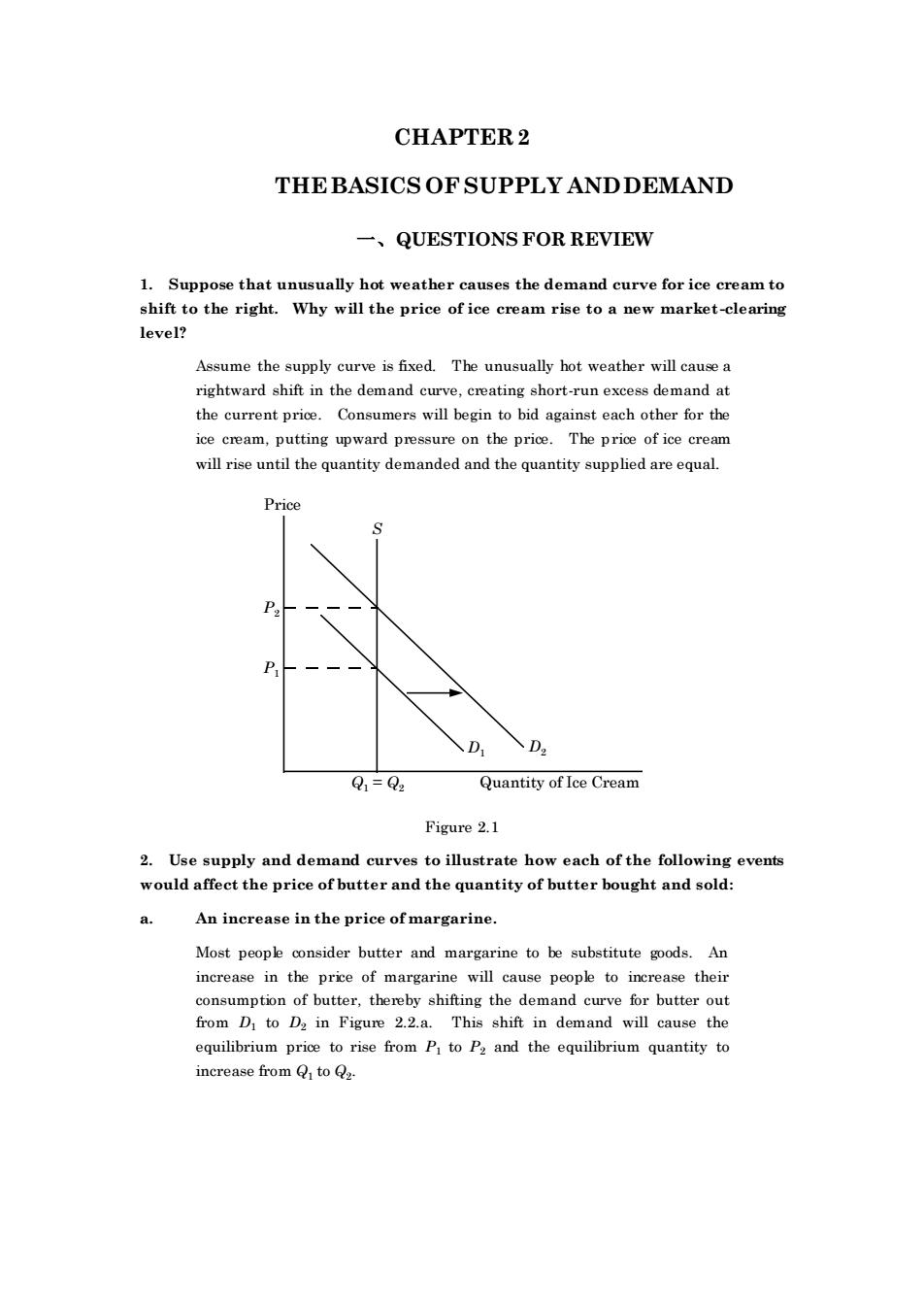
CHAPTER 2 THEBASICS OF SUPPLY ANDDEMAND QUESTIONS FOR REVIEW 1.Suppo se that unusually hot weather causes the demand curve for ice cream to shift to the right.Why will the price of ice cream rise to a new market-clearing level? Assume the supply curve is fixed.The unusually hot weather will cause a rightward shift in the demand curve,creating short-run excess demand at the current price.Consumers will begin to bid against each other for the ice cream,putting on the price.The price ofice cream will rise until the quantity demanded and the quantity supplied are equal Pri D Quantity of Ice Cream Figure 2.1 2.Use supply and demand curves to illustrate how each of the following event would affect the price of butter and the quantity of butter bought and sold An increase in the price of margarine Most people consider butter and margarine to be substitute goods.An increase in the price of margarine will cause people to increase their consumption of butter,thereby shifting the demand curve for butter out from D to Da in Figure 2.2.a.This shift in demand will cause the equilibrium price to rise from P,to po and the equilibrium quantity to increase from to
CHAPTER 2 THE BASICS OF SUPPLY AND DEMAND 一、QUESTIONS FOR REVIEW 1. Suppose that unusually hot weather causes the demand curve for ice cream to shift to the right. Why will the price of ice cream rise to a new market -clearing level? Assume the supply curve is fixed. The unusually hot weather will cause a rightward shift in the demand curve, creating short-run excess demand at the current price. Consumers will begin to bid against each other for the ice cream, putting upward pressure on the price. The price of ice cream will rise until the quantity demanded and the quantity supplied are equal. D1 D2 P1 P2 S Price Q1 = Q2 Quantity of Ice Cream Figure 2.1 2. Use supply and demand curves to illustrate how each of the following events would affect the price of butter and the quantity of butter bought and sold: a. An increase in the price of margarine. Most people consider butter and margarine to be substitute goods. An increase in the price of margarine will cause people to increase their consumption of butter, thereby shifting the demand curve for butter out from D1 to D2 in Figure 2.2.a. This shift in demand will cause the equilibrium price to rise from P1 to P2 and the equilibrium quantity to increase from Q1 to Q2
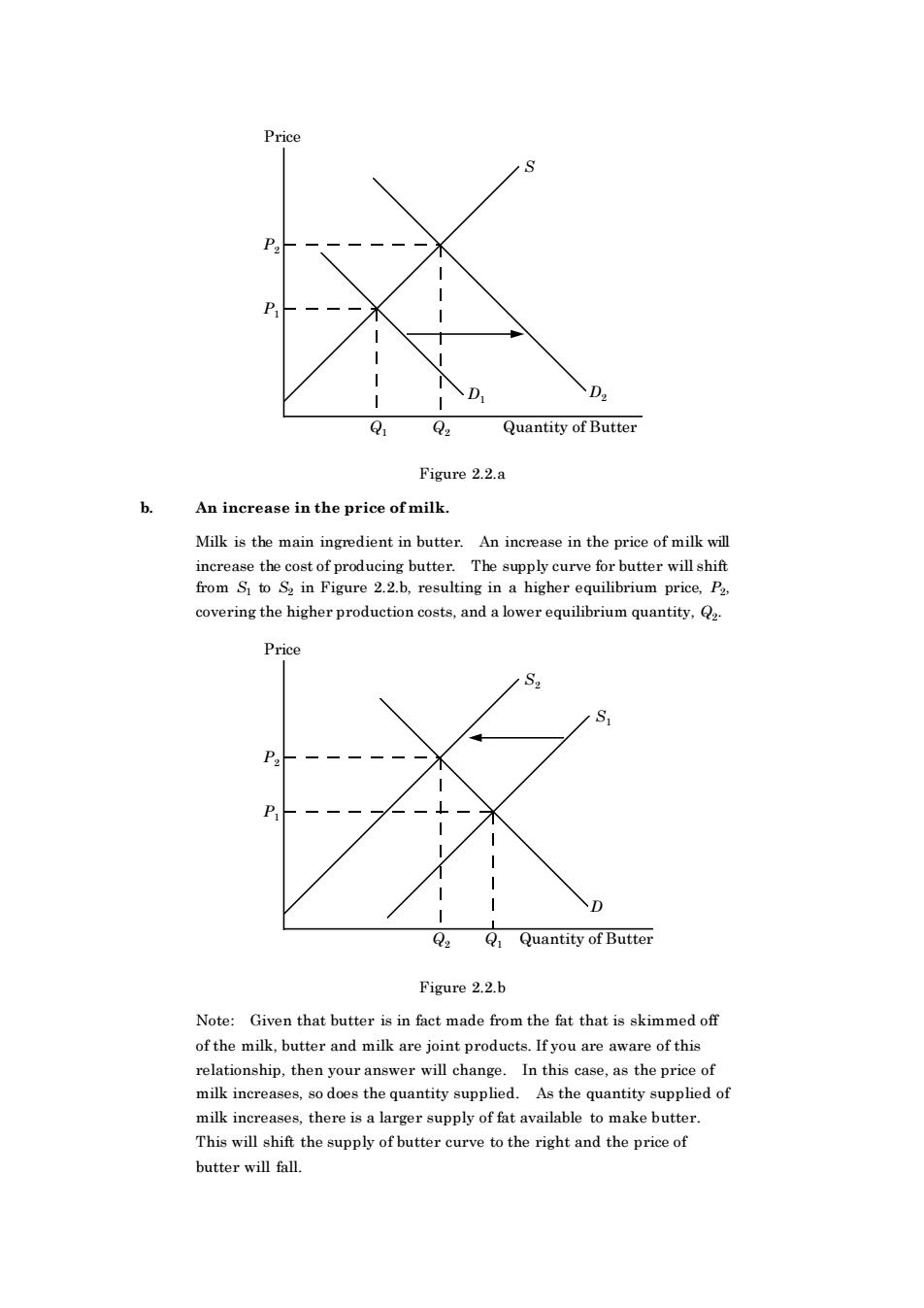
Quantity of Butter Figure 2.2.a An increase in the price ofmilk. Milk is the main ingredient in butter.An increase in the price of milk will increase the cost of producing butter.The supply curve for butter will shift from S to S2 in Figure 2.2.b.resulting in a higher equilibrium price.P. covering the higher production costs,and a lower equilibrium quantity,Q. Price S QQuantity of Butter Figure 2.2.b Note:Given that butter is in fact made from the fat that is skimmed off of the milk.butter and milk are ioint products.If you are aware of this d As the quantity supplied of milk inereases,there is a larger supply of fat available to make butter This will shift the supply of butter curve to the right and the price of butter will fall
D1 D2 P1 P2 S Price Q Quantity of Butter 1 Q2 Figure 2.2.a b. An increase in the price of milk. Milk is the main ingredient in butter. An increase in the price of milk will increase the cost of producing butter. The supply curve for butter will shift from S1 to S2 in Figure 2.2.b, resulting in a higher equilibrium price, P2 , covering the higher production costs, and a lower equilibrium quantity, Q2 . D P1 P2 S2 Price Q Quantity of Butter Q2 1 S1 Figure 2.2.b Note: Given that butter is in fact made from the fat that is skimmed off of the milk, butter and milk are joint products. If you are aware of this relationship, then your answer will change. In this case, as the price of milk increases, so does the quantity supplied. As the quantity supplied of milk increases, there is a larger supply of fat available to make butter. This will shift the supply of butter curve to the right and the price of butter will fall
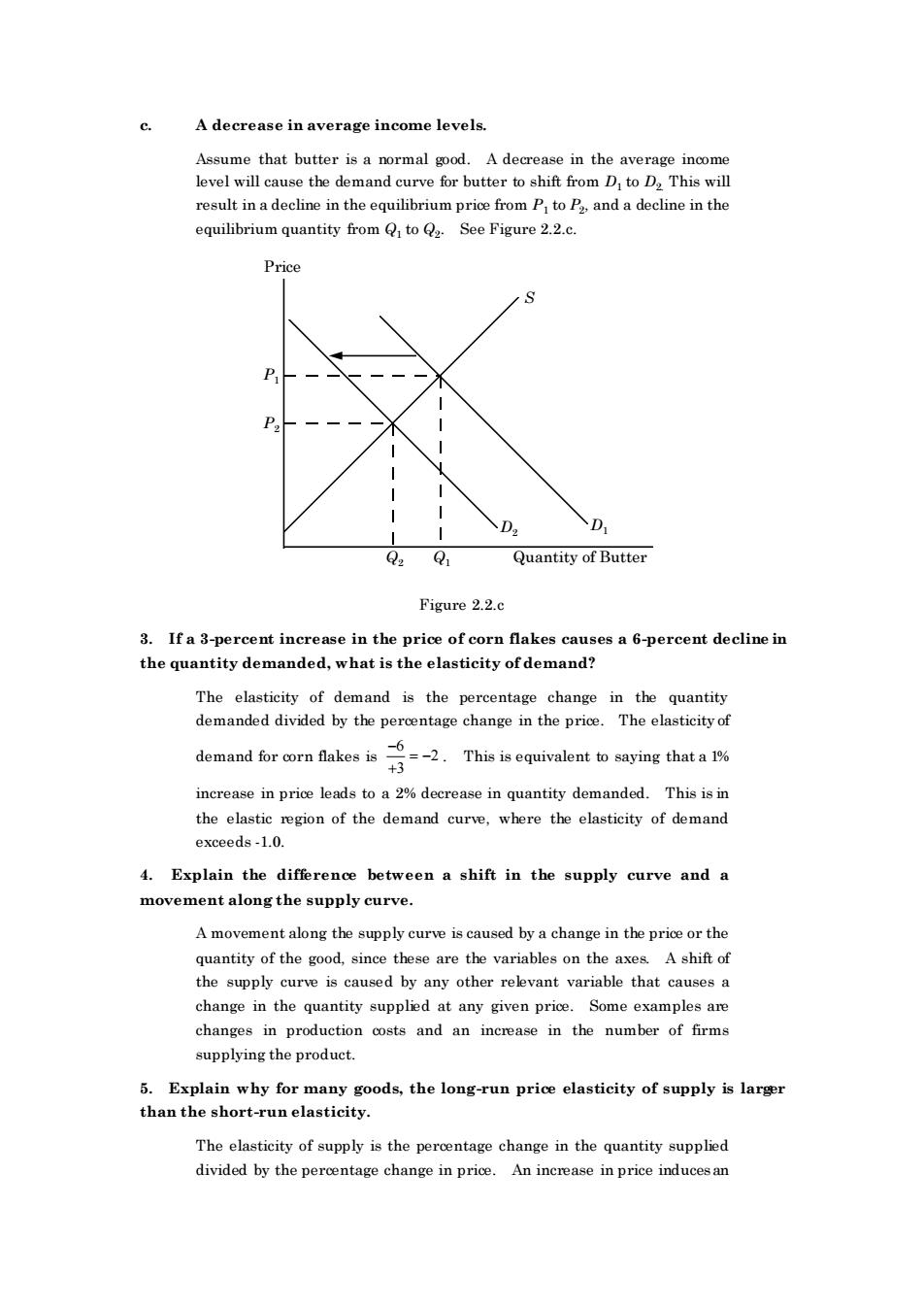
c. A decrease in average income levels. Assume that butter is a normal good.A decrease in the average income level will cause the demand curve for butter to shift from D,to D,This will result in a decline in the equilibrium rice from P toP and a decline in the quantity from,toSee Figure Price D Q。Q1 Quantity of Butter Figure2.2.c 3.If a 3-percent increase in the price of corn flakes causes a 6-percent decline in the quantity demanded,what is the elasticity of demand? The elasticity of demand is the percentage change in the quantity demanded divided by the percentage change in the price.The elasticity of demand or ake:色芳-2.Tsa6 valentn that increase in price leads toa%decrease in quantity demanded.This is i the elastic exceeds-1.0. 4.Explain the difference between a shift in the supply curve and a movement along the supply curve. A movement along the supply curve is caused by a change in the price or the quantity of the good,since these are the variables on the axes.A shift of the supply curv is caused by any other relvant variable that causes a change in the quantity supplied at any given price. Some examples ar changes in production costs and an increase in the number of firms supplying the product. 5.Explain why for many goods,the long-run price elasticity of supply is larger than the short-run elasticity. The elasticity of supply is the percentage change in the quantity supplied divided by the percentage change in price. An increase in price inducesan
c. A decrease in average income levels. Assume that butter is a normal good. A decrease in the average income level will cause the demand curve for butter to shift from D1 to D2. This will result in a decline in the equilibrium price from P1 to P2 , and a decline in the equilibrium quantity from Q1 to Q2 . See Figure 2.2.c. D1 P1 P2 S Price Q Quantity of Butter Q2 1 D2 Figure 2.2.c 3. If a 3-percent increase in the price of corn flakes causes a 6-percent decline in the quantity demanded, what is the elasticity of demand? The elasticity of demand is the percentage change in the quantity demanded divided by the percentage change in the price. The elasticity of demand for corn flakes is − + = − 6 3 2 . This is equivalent to saying that a 1% increase in price leads to a 2% decrease in quantity demanded. This is in the elastic region of the demand curve, where the elasticity of demand exceeds -1.0. 4. Explain the difference between a shift in the supply curve and a movement along the supply curve. A movement along the supply curve is caused by a change in the price or the quantity of the good, since these are the variables on the axes. A shift of the supply curve is caused by any other relevant variable that causes a change in the quantity supplied at any given price. Some examples are changes in production costs and an increase in the number of firms supplying the product. 5. Explain why for many goods, the long-run price elasticity of supply is larger than the short-run elasticity. The elasticity of supply is the percentage change in the quantity supplied divided by the percentage change in price. An increase in price induces an
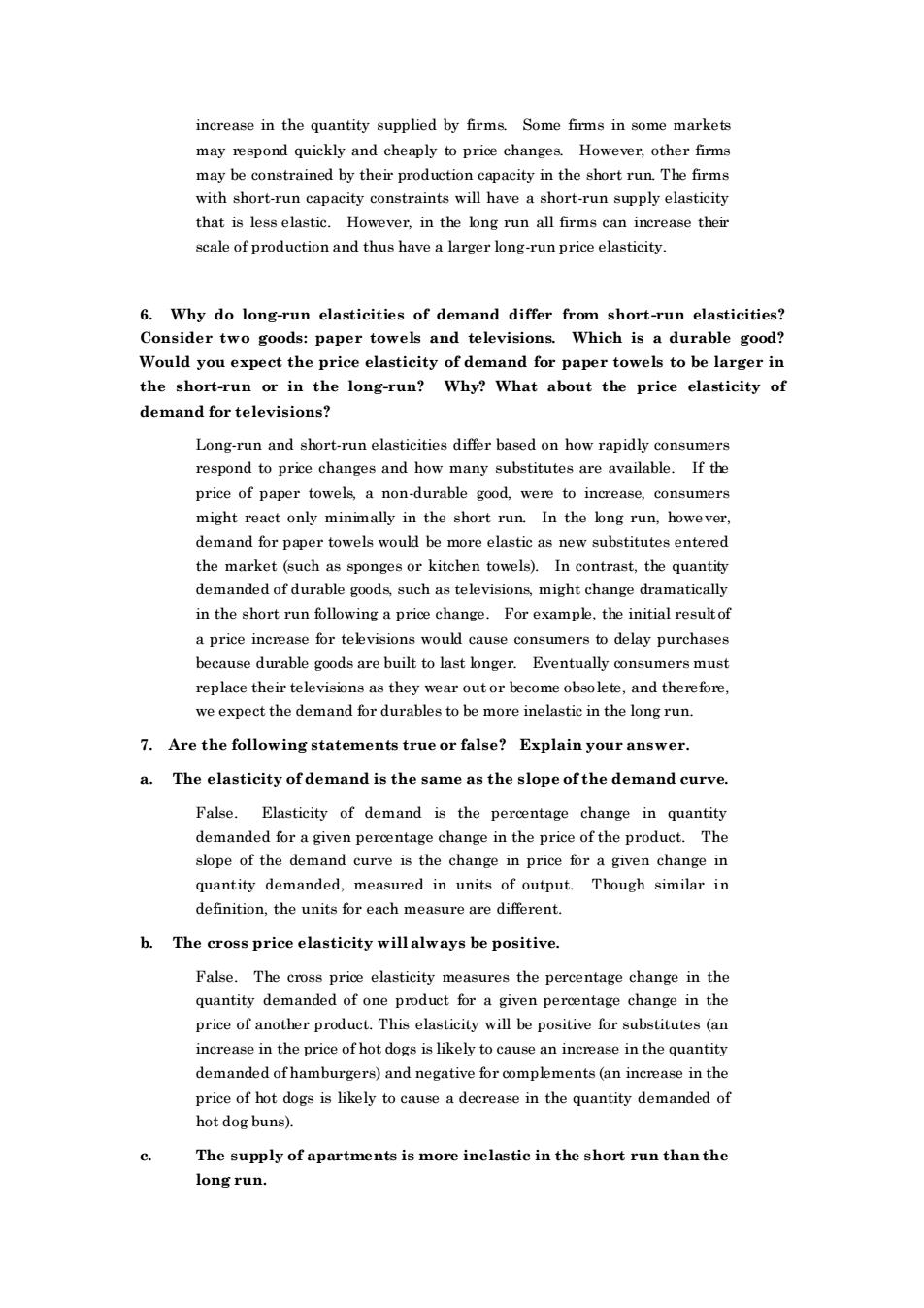
increase in the quantity supplied by firms some firms in some markets may respond quickly and cheaply to price changes However,other firme may be constrained by their production capacity in the short run.The firms with short-run capacity constraints will have a short-run supply elasticity that is less elastic.However,in the long run all firms can increase their scale of production and thus have a larger long-run price elasticity. 6.Why do long-un elasticities of demand difhcaticitie two g wes and televisio able good? t pcctcty of de or ods the short-run or in the long-run?Why?What about the price elasticity of demand for televisions? Long-run and short-run elasticities differ based on how rapidly consumers respond to price changes and how many substitutes are available.If the price of paper towea non-durable to might react only minimally in the short run.In the lng run.bowever demand for paper towels would be more elastic as new substitutes entered the market (such as sponges or kitchen towels).In contrast,the quantity demanded of durable goods such as televisions,might change dramatically in the short run following a price change.For exampk,the initial result of a price increa se for televisions woul cause consumers to delay purchase because durable goods are built to last longer.Eventually consumers must replace their televisions as they wear out or become obsolete,and therefore, we expect the demand for durables to be more inelastic in the long run. 7.Are the following statements true or false?Explain your answer. a.The elasticity of demand is the same as the slope of the demand curve. False.Elasticity of demand is the percentage change in quantity demanded for a given pere change in the price of the produet.Th slope of the demand curve the change in change in quantity demanded,measured in units of output Though similar in definition,the units for each measure are different. b.The cross price elasticity willalways be positive. False.The cross price elasticity measures the percentage change in the quantity demanded of one product for a given percentage change in the se in the price of hot dogs is likely in the quantit demanded of hamburgers)and negative for complments(an increase in the price of hot dogs is likely to cause a decrease in the quantity demanded of hot dog buns). c The supply of apartments is more inelastic in the short run than the long run
increase in the quantity supplied by firms. Some firms in some markets may respond quickly and cheaply to price changes. However, other firms may be constrained by their production capacity in the short run. The firms with short-run capacity constraints will have a short-run supply elasticity that is less elastic. However, in the long run all firms can increase their scale of production and thus have a larger long-run price elasticity. 6. Why do long-run elasticities of demand differ from short-run elasticities? Consider two goods: paper towels and televisions. Which is a durable good? Would you expect the price elasticity of demand for paper towels to be larger in the short-run or in the long-run? Why? What about the price elasticity of demand for televisions? Long-run and short-run elasticities differ based on how rapidly consumers respond to price changes and how many substitutes are available. If the price of paper towels, a non-durable good, were to increase, consumers might react only minimally in the short run. In the long run, however, demand for paper towels would be more elastic as new substitutes entered the market (such as sponges or kitchen towels). In contrast, the quantity demanded of durable goods, such as televisions, might change dramatically in the short run following a price change. For example, the initial result of a price increase for televisions would cause consumers to delay purchases because durable goods are built to last longer. Eventually consumers must replace their televisions as they wear out or become obsolete, and therefore, we expect the demand for durables to be more inelastic in the long run. 7. Are the following statements true or false? Explain your answer. a. The elasticity of demand is the same as the slope of the demand curve. False. Elasticity of demand is the percentage change in quantity demanded for a given percentage change in the price of the product. The slope of the demand curve is the change in price for a given change in quantity demanded, measured in units of output. Though similar in definition, the units for each measure are different. b. The cross price elasticity will always be positive. False. The cross price elasticity measures the percentage change in the quantity demanded of one product for a given percentage change in the price of another product. This elasticity will be positive for substitutes (an increase in the price of hot dogs is likely to cause an increase in the quantity demanded of hamburgers) and negative for complements (an increase in the price of hot dogs is likely to cause a decrease in the quantity demanded of hot dog buns). c. The supply of apartments is more inelastic in the short run than the long run
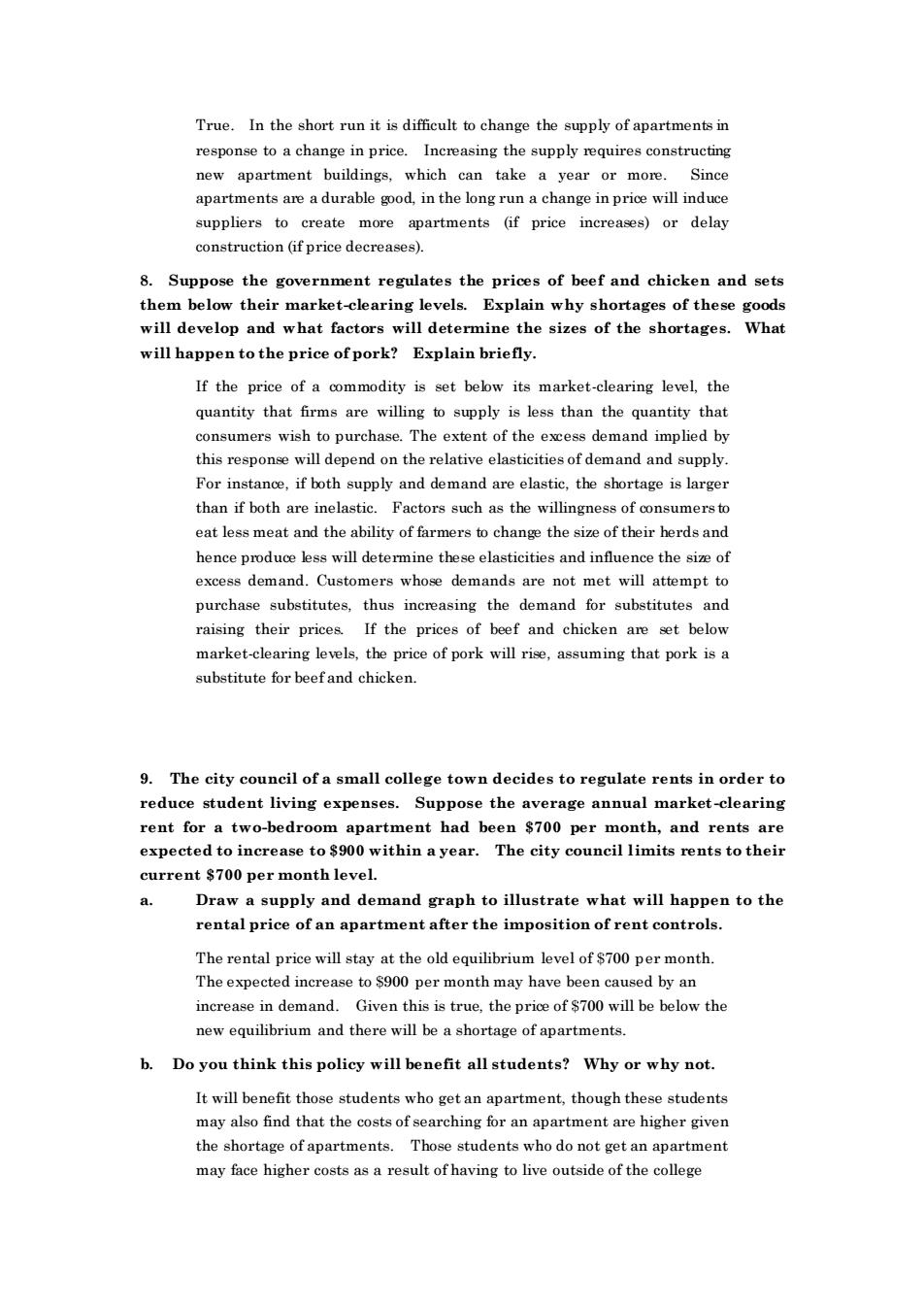
True.In the short run it is difficult to change the supply of apartments in new apartment build lings,which can take a year or more. Sinc apartments are a durable good,in the long run a change in price will induce suppliers to create more apartments (if price increases)or delay construction (if price decreases). 8.Suppose the government regulates the prices of beef and chicken and sets blo theExplain hy shorage of thes good will develop e the sizes of the tages. will happen to the price ofpork?Explain briefly. If the price of a commodity is set bebw its market-clearing level,the quantity that firms are willing to supply is less than the quantity that consumers wish to purchase.The extent of the excess demand implied by thisrespo ill depend on the relative elasticities of demand and supply For instanc,if both supply and demand are,the shortage is than if both are inelastic Factors such as the willingnesso eat less meat and the ability of farmers to change the size of their herds and hence produce less will determine these elasticities and influence the size of excess demand.Customers whose demands are not met will attempt to purchase substitutes,thus inc ing the demand for substitutes raising their prices If the prices of bef and market-clearing levels,the price of pork will rise,assuming that pork is a substitute for beefand chicken. 9.The city council of a small college town decides to regulate rents in order to reduce student living expenses.Suppose the average annual market-clearing rent for a two-bedro ent h had been $700 per nth and expected to increase to $900 within ayear.The city counci mits rents to their current $700 per month level. a。 Draw a supply and demand graph to illustrate what will happen to the rental price of an apartment after the imposition of rent controls. The rental price will stay at the old eguilibrium level of S700 per month The e rease to$900p er mo nth ma ay used by an increase in demand Given th istrue,the price fwill be below the new equilibrium and there will be a shortage of apartments b.Do you think this policy will benefit all students?Why or why not. It will benefit those students who get an apartment,though these students may also find that the costs of searching for an apartment are higher given the shortage of apartments.Those students who do not get an apartment may face higher costs as a result of having to live outside of the college
True. In the short run it is difficult to change the supply of apartments in response to a change in price. Increasing the supply requires constructing new apartment buildings, which can take a year or more. Since apartments are a durable good, in the long run a change in price will induce suppliers to create more apartments (if price increases) or delay construction (if price decreases). 8. Suppose the government regulates the prices of beef and chicken and sets them below their market-clearing levels. Explain why shortages of these goods will develop and what factors will determine the sizes of the shortages. What will happen to the price of pork? Explain briefly. If the price of a commodity is set below its market-clearing level, the quantity that firms are willing to supply is less than the quantity that consumers wish to purchase. The extent of the excess demand implied by this response will depend on the relative elasticities of demand and supply. For instance, if both supply and demand are elastic, the shortage is larger than if both are inelastic. Factors such as the willingness of consumers to eat less meat and the ability of farmers to change the size of their herds and hence produce less will determine these elasticities and influence the size of excess demand. Customers whose demands are not met will attempt to purchase substitutes, thus increasing the demand for substitutes and raising their prices. If the prices of beef and chicken are set below market-clearing levels, the price of pork will rise, assuming that pork is a substitute for beef and chicken. 9. The city council of a small college town decides to regulate rents in order to reduce student living expenses. Suppose the average annual market -clearing rent for a two-bedroom apartment had been $700 per month, and rents are expected to increase to $900 within a year. The city council limits rents to their current $700 per month level. a. Draw a supply and demand graph to illustrate what will happen to the rental price of an apartment after the imposition of rent controls. The rental price will stay at the old equilibrium level of $700 per month. The expected increase to $900 per month may have been caused by an increase in demand. Given this is true, the price of $700 will be below the new equilibrium and there will be a shortage of apartments. b. Do you think this policy will benefit all students? Why or why not. It will benefit those students who get an apartment, though these students may also find that the costs of searching for an apartment are higher given the shortage of apartments. Those students who do not get an apartment may face higher costs as a result of having to live outside of the college
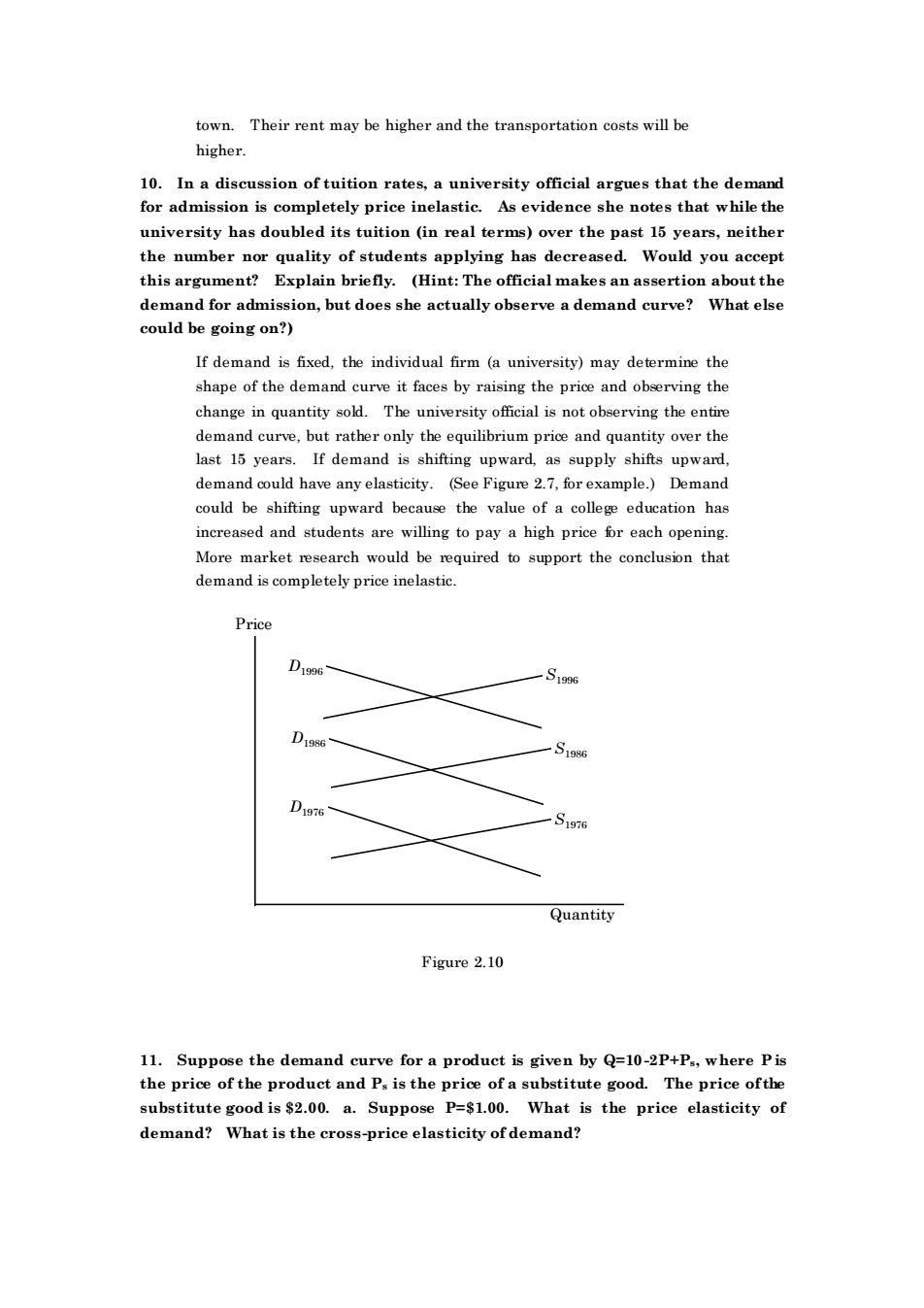
town.Their rent may be higher and the transportation costs will be higher. for admission is completely price inelastic.As evidence she notes that while the university has doubled its tuition (in real terms)over the past 15 years,neither the number nor quality of students applying has decreased.Would you accept this argument?Explain briefly.(Hint:The official makes an assertion about the n,but do she eactually observe a demand curve?What else could be going on?) If demand is fixed,the individual firm (a university)may determine the shape of the demand curve it faces by raising the price and observing the change in quantity sold.The university official is not observing the entire demand curve.but rather only the equilibrium price and quantity over the last 15 years.If demand is shifting upward,as supply pward. demand oould have any elasticity.See Figure 2.7.for example)Deman could be shifting upward because the value of a college education has increased and students are willing to pay a high price for each opening. More market research would be required to support the conclusion that demand is completely price inelastic. Price S Quantity Figure2.10 11.Suppose the demand curve for a product is given by Q=10-2P+P.where Pis the price of the product and P.is the price of a substitute good.The price ofthe substitute good is S2.00.a.Suppose P=S1.00.What is the price elasticity of demand?What is the cross-price elasticity ofdemand?
town. Their rent may be higher and the transportation costs will be higher. 10. In a discussion of tuition rates, a university official argues that the demand for admission is completely price inelastic. As evidence she notes that while the university has doubled its tuition (in real terms) over the past 15 years, neither the number nor quality of students applying has decreased. Would you accept this argument? Explain briefly. (Hint: The official makes an assertion about the demand for admission, but does she actually observe a demand curve? What else could be going on?) If demand is fixed, the individual firm (a university) may determine the shape of the demand curve it faces by raising the price and observing the change in quantity sold. The university official is not observing the entire demand curve, but rather only the equilibrium price and quantity over the last 15 years. If demand is shifting upward, as supply shifts upward, demand could have any elasticity. (See Figure 2.7, for example.) Demand could be shifting upward because the value of a college education has increased and students are willing to pay a high price for each opening. More market research would be required to support the conclusion that demand is completely price inelastic. S1976 Price Quantity S1986 S1996 D1996 D1986 D1976 Figure 2.10 11. Suppose the demand curve for a product is given by Q=10-2P+Ps, where P is the price of the product and Ps is the price of a substitute good. The price of the substitute good is $2.00. a. Suppose P=$1.00. What is the price elasticity of demand? What is the cross-price elasticity of demand?

First you need to find the quantity demanded at the price of $1.00. Q=10-2(1+210. Price elasticity of demand 006-2)=-品=02 P△O Crosprice elasticity of demand= 4=60=02 Suppose the price of the good,P,goes to $2.00.Now what is the price elasticity of demand?What is the cross-price elasticity of demand? First you need to find the quantity demanded at the price of $2.00. Q=10-22+2=8. Price elasticity of demand= 6-6-2=-05 P△Q」 Cro-price elasticity ofdemand=(025 12.Suppose that rather than the declining demand assumed in Example 2.8,a decreas e in the cost of co production causes the ply curve to shift to the right by 40 percent.How will the price ofcopper change If the supply curve shifts to the right by40%then supplied will be 140 perent of the old quantity supplied at every price. The new supply curve is therefore Q=1.4*(-4.5+16P)=6.3+22.4P.To find the new equilibrium price of copper,set the new supply equal to demand so that-6.3+22.4P=13.5-8P. Solving for price results in P=65 cents per pound for the new equilibrium price.The price decreased by 10cents per pound,or 13.3% 13.Suppose the demand for natural gas is perfectly inelastic.What would be the effect,ifany,of natural gas price controls? If the demand for natural gas is perfectly inelastic.then the demand curve is vertical.Consume price this quantity the quantity demanded
First you need to find the quantity demanded at the price of $1.00. Q=10-2(1)+2=10. Price elasticity of demand = P Q Q P = 1 10 (−2) = − 2 10 = −0.2. Cross-price elasticity of demand = Ps Q Q Ps = 2 10 (1) = 0.2. b. Suppose the price of the good, P, goes to $2.00. Now what is the price elasticity of demand? What is the cross-price elasticity of demand? First you need to find the quantity demanded at the price of $2.00. Q=10-2(2)+2=8. Price elasticity of demand = P Q Q P = 2 8 (−2) = − 4 8 = −0.5. Cross-price elasticity of demand = Ps Q Q Ps = 2 8 (1) = 0.25. 12. Suppose that rather than the declining demand assumed in Example 2.8, a decrease in the cost of copper production causes the supply curve to shift to the right by 40 percent. How will the price of copper change? If the supply curve shifts to the right by 40% then the new quantity supplied will be 140 percent of the old quantity supplied at every price. The new supply curve is therefore Q’ = 1.4*(-4.5+16P) = -6.3+22.4P. To find the new equilibrium price of copper, set the new supply equal to demand so that –6.3+22.4P=13.5-8P. Solving for price results in P=65 cents per pound for the new equilibrium price. The price decreased by 10 cents per pound, or 13.3%. 13. Suppose the demand for natural gas is perfectly inelastic. What would be the effect, if any, of natural gas price controls? If the demand for natural gas is perfectly inelastic, then the demand curve is vertical. Consumers will demand a certain quantity and will pay any price for this quantity. In this case, a price control will have no effect on the quantity demanded

二、EXERCISES 1.Suppose the demand curve for a product is given by Q=3002P+4I.where lis average income measured in thousands of dollars.The supply curve is Q=3P-50. a.If I=25,find the market clearing price and quantity for the product. Given I=25,the demand curve becomes Q=300-2P+4*25.or Q=400-2P Setting demand equal to supply we can solve for P and thenQ: 4002P=3P-50 P=90 Q=220. b.If I=50,find the market clearing price and quantity for the product. Given I=50,the demand curve becomes Q=300-2P+4*50.or Q=500-2P Setting demand equal to supply we can solve for P and then Q: 500-2P=3P.50 P=110 Q=280. c.Draw a graph to illustrate your answers. Equilibrium price and quantity are found at the intersection of the demand and supply c g When the income level increases in part b.the demand curve w hif and to the right.The of the ew demand curve and the supply curves the newequ point. 2.Consider a competitive market for which the quantities demanded and supplied (per year)at various prices are given as follows: Price Demand Supply () (millions) (millions) 22 80 20 16 100 18 120 16 20 Calculate the price elasticity of demand when the price is $80 and when the price is $100. We know that the price elasticity of demand may be calculated using equation 2.1 from the text:
二、EXERCISES 1. Suppose the demand curve for a product is given by Q=300-2P+4I, where I is average income measured in thousands of dollars. The supply curve is Q=3P-50. a. If I=25, find the market clearing price and quantity for the product. Given I=25, the demand curve becomes Q=300-2P+4*25, or Q=400-2P. Setting demand equal to supply we can solve for P and then Q: 400-2P=3P-50 P=90 Q=220. b. If I=50, find the market clearing price and quantity for the product. Given I=50, the demand curve becomes Q=300-2P+4*50, or Q=500-2P. Setting demand equal to supply we can solve for P and then Q: 500-2P=3P-50 P=110 Q=280. c. Draw a graph to illustrate your answers. Equilibrium price and quantity are found at the intersection of the demand and supply curves. When the income level increases in part b, the demand curve will shift up and to the right. The intersection of the new demand curve and the supply curve is the new equilibrium point. 2. Consider a competitive market for which the quantities demanded and supplied (per year) at various prices are given as follows: Price ($) Demand (millions) Supply (millions) 60 22 14 80 20 16 100 18 18 120 16 20 a. Calculate the price elasticity of demand when the price is $80 and when the price is $100. We know that the price elasticity of demand may be calculated using equation 2.1 from the text:
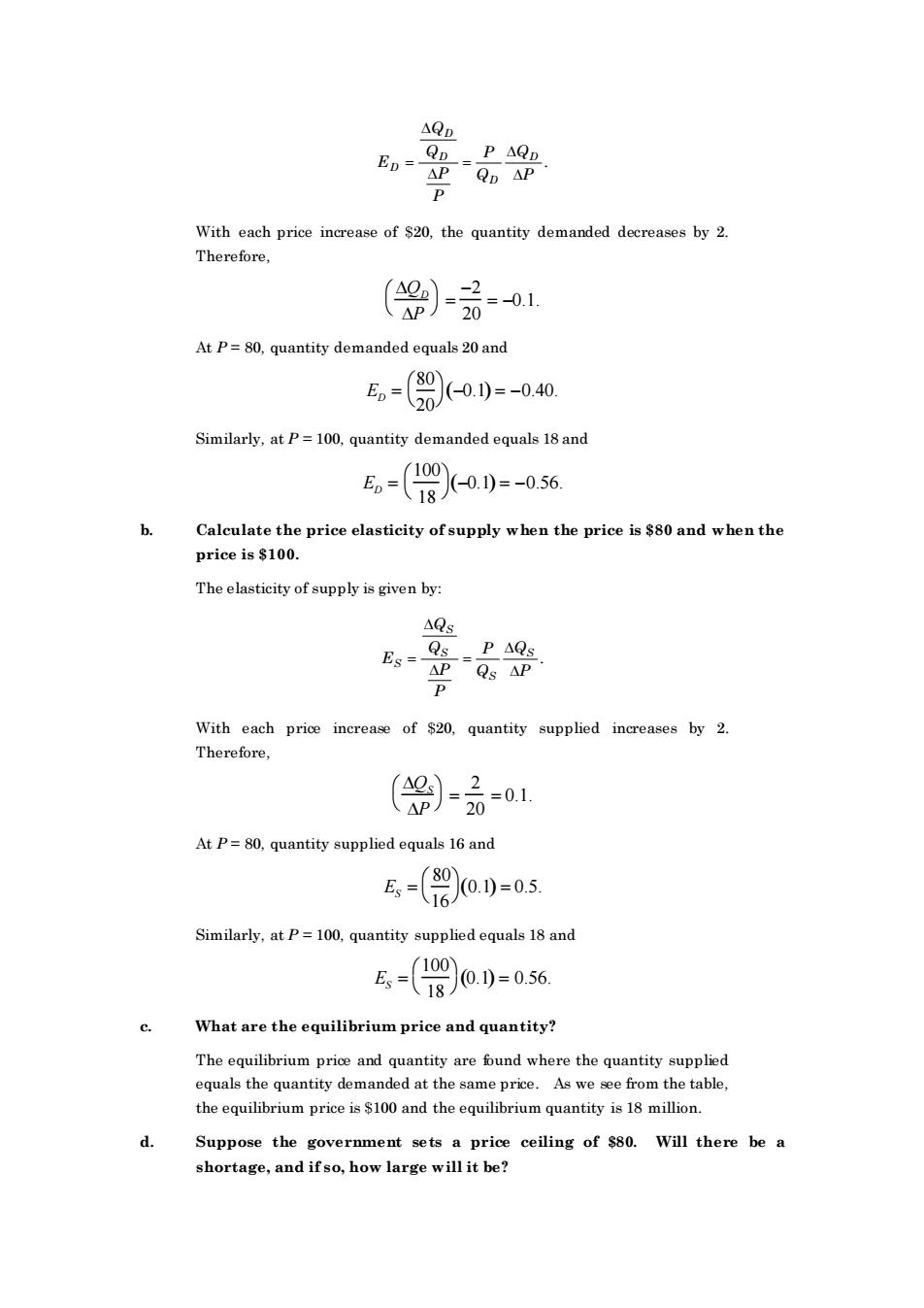
With each price increase of $20.the quantity demanded decreases by 2. Therefore, (g)品1 At P=80,quantity demanded equals 20 and E,=(80)0.0=-040, Similarly,at P=100,quantity demanded equals 18 and 6-(0=06 Calculate the price elasticity of supply when the price is $80 and when the price is $100. The elasticity of supply is given by: △Qs p△Q P With of quantity supplied increase by2. Therefore, (9)-号=1 At P=80.quantity supplied equals 16 and =(o0=05 Similarly,at P=100,quantity supplied equals 18 and 点-(得0)=06 What are the equilibrium price and quantity? ntity equals the e quantity demar the equilibrium price is$100 and the equilibrium quantity is 18 million. d. Suppose the government sets a price ceiling of $80.Will there be a shortage,and ifso,how large will it be?
E Q Q P P P Q Q P D D D D D = = . With each price increase of $20, the quantity demanded decreases by 2. Therefore, QD P = −2 20 = −0.1. At P = 80, quantity demanded equals 20 and ED = 80 20 (−0.1) = −0.40. Similarly, at P = 100, quantity demanded equals 18 and ED = 100 18 (−0.1) = −0.56. b. Calculate the price elasticity of supply when the price is $80 and when the price is $100. The elasticity of supply is given by: E Q Q P P P Q Q P S S S S S = = . With each price increase of $20, quantity supplied increases by 2. Therefore, QS P = 2 20 = 0.1. At P = 80, quantity supplied equals 16 and ES = 80 16 (0.1) = 0.5. Similarly, at P = 100, quantity supplied equals 18 and ES = 100 18 (0.1) = 0.56. c. What are the equilibrium price and quantity? The equilibrium price and quantity are found where the quantity supplied equals the quantity demanded at the same price. As we see from the table, the equilibrium price is $100 and the equilibrium quantity is 18 million. d. Suppose the government sets a price ceiling of $80. Will there be a shortage, and if so, how large will it be?
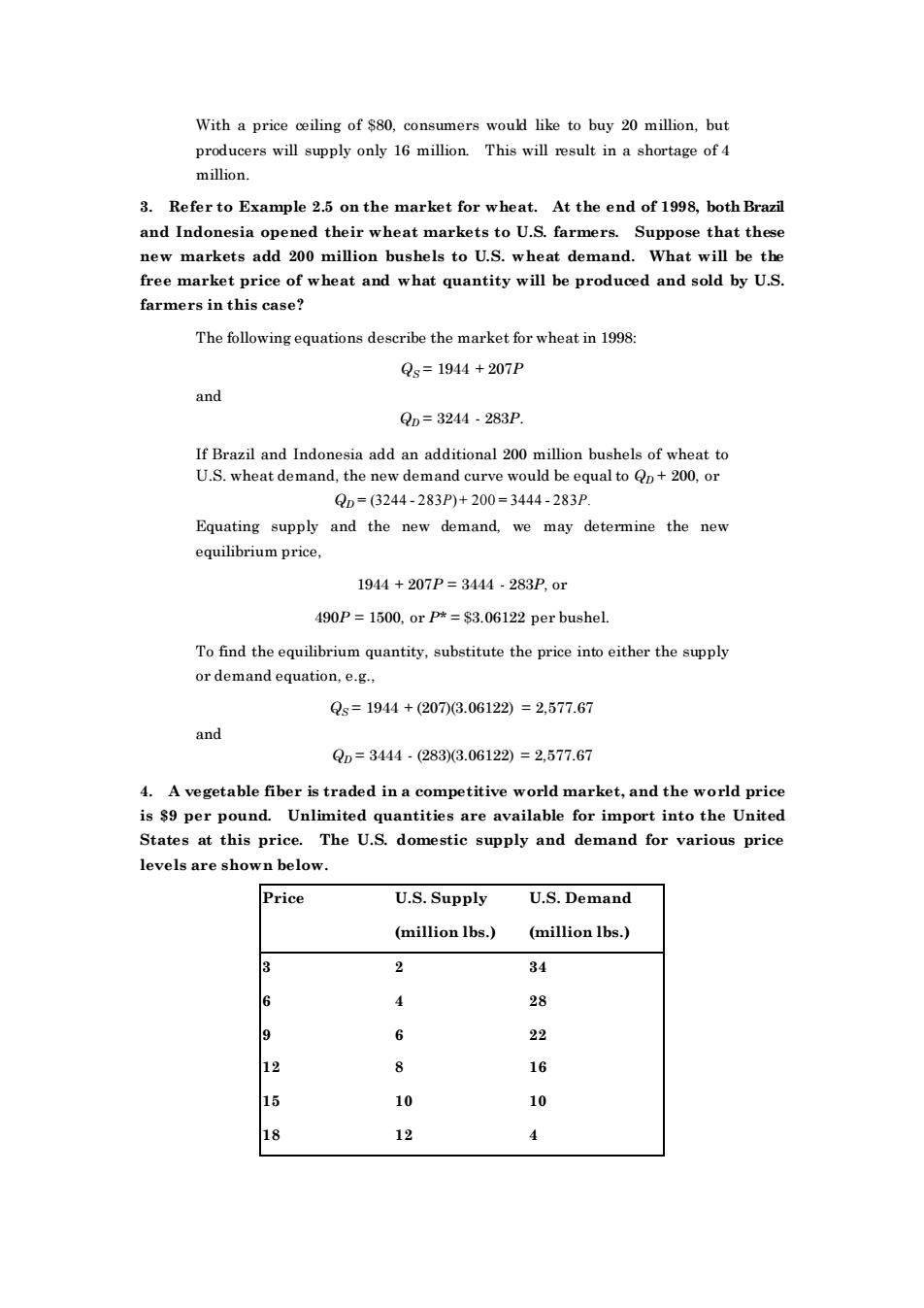
With a price ceiling of $80,consumers would like to buy 20 million,but producera will auppy.This will eu inashortage of million 3.Refer to Example 2.5 on the market for wheat.At the end of 1998 both Brazil and Indonesia opened their wheat markets to U.S.farmers.Suppose that these new markets add 200 million bushels to U.S.wheat demand.What will be the free market price of wheat and what quantity will be produced and sold by U.S. farmers in this case? The following equations describe the market for wheat in 1998: Qs=194+207P and Qm=3244283P If Brazil and Indonesia add an additional 200 million bushels of wheat to U.S.wheat demand,the new demand curve would be equal to +200.or Q=(6244-283P)+200=3444-283P, Equating supply and the new demand,we may determine the nev equilibrium price. 1944+207P=3444-283P,0r 490P=1500.or P*=$3.06122 per bushel To find the equilibrium quantity,substitute the price into either the supply or demand equation,e.g., Qg=1944+(2073.06122=2,577.67 and QD=3444.(2833.06122=2,577.67 4.A vegetable fiber is traded in a competitive world market,and the world price is $9 per und.Unlimited are available for rt into the United States at this price. The U.S.domestic supply and demand for various price levels are shown below. Price U.S.Supply U.S.Demand (million lbs.) (million lbs.) 34 28 6 22 16 10 10 12
With a price ceiling of $80, consumers would like to buy 20 million, but producers will supply only 16 million. This will result in a shortage of 4 million. 3. Refer to Example 2.5 on the market for wheat. At the end of 1998, both Brazil and Indonesia opened their wheat markets to U.S. farmers. Suppose that these new markets add 200 million bushels to U.S. wheat demand. What will be the free market price of wheat and what quantity will be produced and sold by U.S. farmers in this case? The following equations describe the market for wheat in 1998: QS = 1944 + 207P and QD = 3244 - 283P. If Brazil and Indonesia add an additional 200 million bushels of wheat to U.S. wheat demand, the new demand curve would be equal to QD + 200, or QD = (3244 - 283P) + 200 = 3444 - 283P. Equating supply and the new demand, we may determine the new equilibrium price, 1944 + 207P = 3444 - 283P, or 490P = 1500, or P* = $3.06122 per bushel. To find the equilibrium quantity, substitute the price into either the supply or demand equation, e.g., QS = 1944 + (207)(3.06122) = 2,577.67 and QD = 3444 - (283)(3.06122) = 2,577.67 4. A vegetable fiber is traded in a competitive world market, and the world price is $9 per pound. Unlimited quantities are available for import into the United States at this price. The U.S. domestic supply and demand for various price levels are shown below. Price U.S. Supply U.S. Demand (million lbs.) (million lbs.) 3 2 34 6 4 28 9 6 22 12 8 16 15 10 10 18 12 4